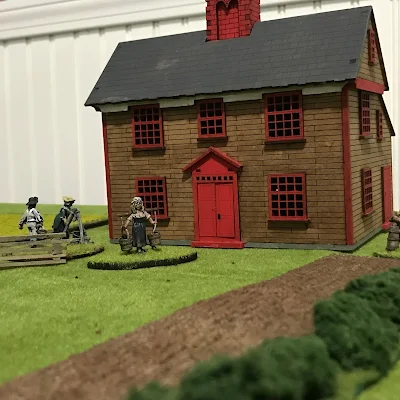In the game an American Brigade must hold up an advancing British column for seven turns. I based it on the action of Pell's Point in October 1776. I added plenty of fences and walls and hedges to break up the landscape and give the defenders cover. The American commander deployed two regiments on either side of the road behind fences. The 14th and 26th Continental regiments on the right and the 3rd and 13th Continentals on the left. The artillery was held back as crossing fences would be an issue (you have to knock them down). The British entered with a Brigade of three regiments, the 10th, 33rd and 23rd and a medium artillery gun on the left of the road. On the right were two loyalist regiments, the New York Volunteers (NYV) and the Prince of Wales America Regiment (PoWAR) with a light gun. The Guards Brigade was held in reserve.
As the Crown Forces advanced onto the field the Americans waited until they were within musket range. Once there they fired and immediately fell back towards the next fence line. In the rules, if you don't move during the movement phase you can use a fire and retire. Once you fire you turn the unit to face the rear and move back half your movement rate. So they get to cause some casualties but get out of the way before the enemy can close. Hopeful, because if the enemy can close you are in a heap of trouble.
This time it worked. The Americans fell back to the next line of cover. The Crown forces kept advancing but did take some casualties. Eventually one British Regiment (33rd) did go shaken but quickly recovered. Once the Americans ran out of positions to retire to it was time for them to leave the field.
Rather then a exciting game it turned into more of a learning experience in testing out a new wrinkle in the rules. A tactical exercise. I have long played the Fife and Drum miniature rules (with some modifications) for my War of 1812 games. They provide a fun and and fast game. Because they are one page long they are easy to learn and you play the game rather then spend your time looking up rules and interpretation. For an explanation of his the rules see https://bravefusiliers.blogspot.com/2019/11/rules-i-use-for-wargaming-war-of-1812.html
They provided an interesting game which reflected many a action during the war. The Americans were not going to stop the British, but could wear then down and slow them up. In this way it was a fun learning experience. The fire and retire rule worked very well. But of course you need a series of good positions to falk back to each turn. And that is not always going to happen. I also got to get my newest regiments onto the field for the first time. Both the Prince of Wales and the 10th fought well I am glad to say.
If you are interested in the period I would highly recommend these rules.




















.jpeg)











